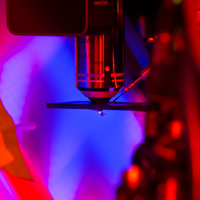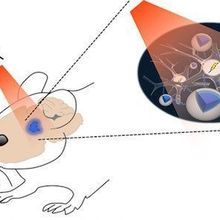optogenetics

Neuron-Released Protein Can Set Off Inflammation: Study
Marcus A. Banks | Aug 19, 2021 | 3 min read
Research in mice suggests that moderating nerve activity with drugs or electrical pulses could modify tissue immune responses, curtailing the chronic pain often associated with inflammatory conditions.

AI Controls Laser-Guided Robot Worms
Ruth Williams | Jul 8, 2021 | 3 min read
Automated control of light-responsive nematode worms marks the first foray into the development of multicellular, biorobotic organisms.

Blind Patient Recovers Partial Vision with Optogenetics
Alejandra Manjarrez, PhD | May 24, 2021 | 4 min read
After receiving an intraocular injection of the gene for a light-sensitive protein, a 58-year-old man diagnosed with the neurodegenerative eye disease retinitis pigmentosa was able to locate objects on a table using engineered goggles.

Mice Share Each Other’s Pain and Fear
Amanda Heidt | Jan 14, 2021 | 5 min read
The animals adopt the emotional state of their cagemates, and the parts of the brain engaged during the process are different for pain and fear, according to a new study.

Researchers Make Mice Smell Odors that Aren’t Really There
Ruth Williams | Jun 18, 2020 | 3 min read
Using optogenetics, scientists have simulated the sense of smell directly within the mouse brain to investigate the nature of olfactory perception.

How Manipulating Rodent Memories Can Elucidate Neurological Function
Amber Dance | May 1, 2020 | 10+ min read
Strategies to make lab animals forget, remember, or experience false recollections probe how memory works, and may inspire treatments for neurological diseases.

Infographic: Messing with a Mouse’s Memory
Amber Dance | May 1, 2020 | 3 min read
Researchers have developed ways to manipulate neurons involved in a particular memory to make mice recall an experience or to remember something that never happened.

Image of the Day: Virtual Landscape
Emily Makowski | Nov 25, 2019 | 2 min read
Flashing lights activate fly navigation neurons.

Glowing Proteins Enable Stem Cell Stimulation for Stroke Recovery in Mice
Nicoletta Lanese | Oct 1, 2019 | 3 min read
A new method helps neural stem cells form synaptic connections, thereby restoring lost brain function.

Infographic: Light in the Dark
Nicoletta Lanese | Oct 1, 2019 | 1 min read
A new tool helps stem cells integrate with host neural circuitry after implantation in mice.

Remote Control of Peripheral Nerves
Ruth Williams | Oct 1, 2019 | 3 min read
An implantable wireless device with microfluidic and optical components allows manipulation of individual nerve fibers in mice’s extremities.

The Cerebellum’s Secrets: A Profile of Kamran Khodakhah
Anna Azvolinsky | Oct 1, 2019 | 8 min read
The Albert Einstein College of Medicine neuroscientist has revealed surprising functions of the brain region, such as its role in the brain’s rewards circuits and in addiction.

Infographic: Open and shut
Chia-Yi Hou | Sep 1, 2019 | 1 min read
Researchers devise a way to make plants’ stomata open and close more quickly.

A Synthetic Ion Channel Makes Plants Grow Faster
Chia-Yi Hou | Sep 1, 2019 | 3 min read
Arabidopsis with guard cells modified by a light-activated potassium ion channel can open and close stomata more quickly, conserving water.

Optogenetic Manipulations Create Perception Without Sensory Input
Ruth Williams | Jul 18, 2019 | 3 min read
Advanced single-cell optogenetic tools have enabled researchers to induce a learned behavior in mice without the associated visual cue.

Image of the Day: Bright Idea
Shawna Williams | Nov 5, 2018 | 1 min read
Researchers flipped light-sensitive proteins upside down for a new twist on optogenetics.

Using Temperature-Sensitive Channels to Study Neural Circuitry
Devika G. Bansal | Nov 1, 2018 | 8 min read
Meet the researchers building a thermogenetic toolbox.

Forgotten Memories Brought Back in Mice
Sukanya Charuchandra | Jul 5, 2018 | 3 min read
By stimulating specific neurons in mouse brains, researchers demonstrate that memories from infancy are not lost, but merely difficult to access.

Here Comes Single-Cell Optogenetics
Ruth Williams | Mar 1, 2018 | 3 min read
A new protein may allow researchers to home in on individual neurons, determining their activity minute by minute.

DBS with Nanoparticle-Based Optogenetics Modifies Behavior in Mice
Diana Kwon | Feb 8, 2018 | 5 min read
Researchers develop a new technique to selectively activate neurons deep in the rodent brain, taking a step toward noninvasive brain stimulation for neurological disorders.
